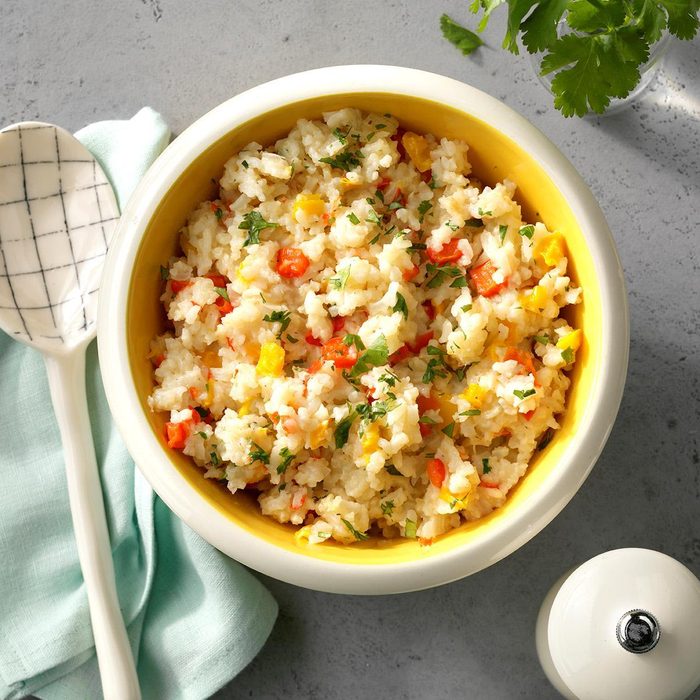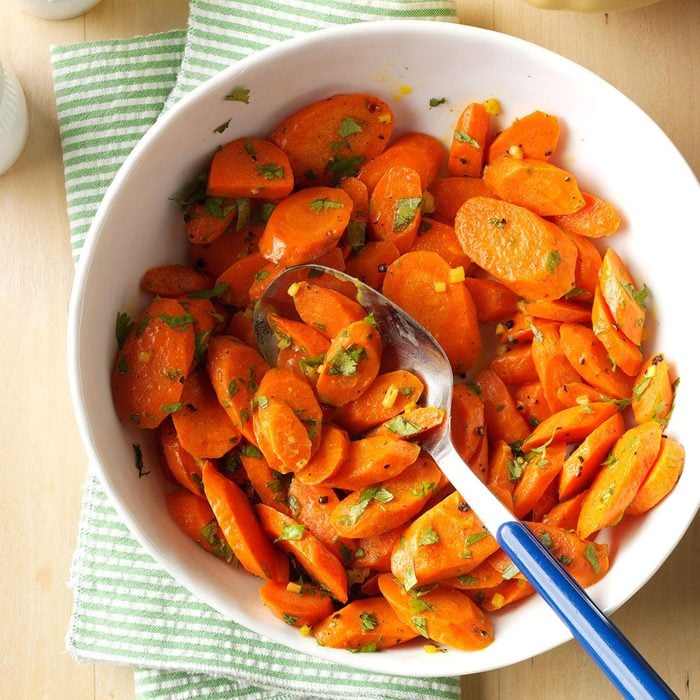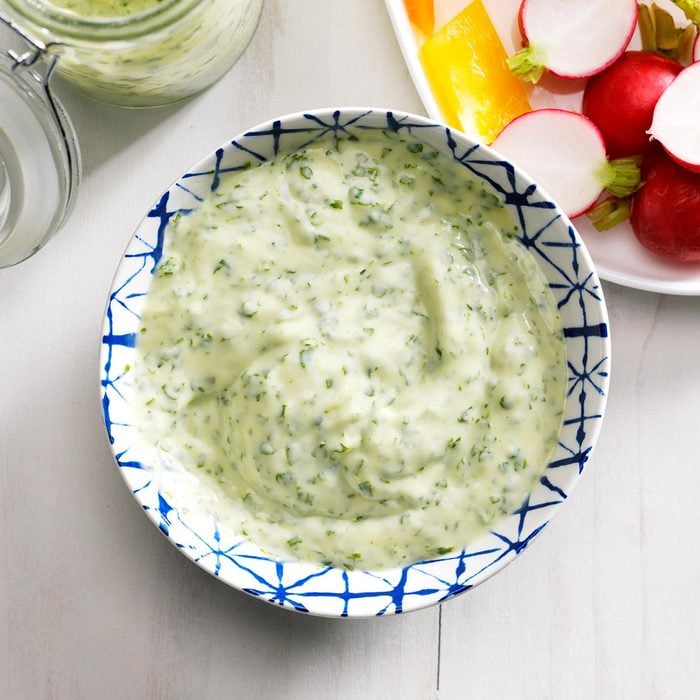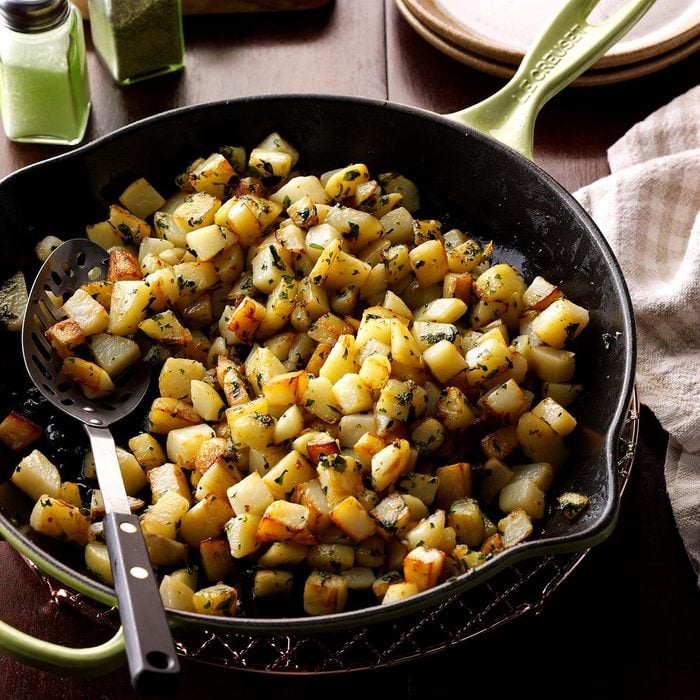For fresh herbs, proximity is everything. If you have easy access to cilantro by growing it indoors in pots, you will suddenly find yourself garnishing everything with this leafy alternative to the more pedestrian parsley.
Most of us only buy fresh cilantro when we need a bunch of it for salsa, and then the leftover cilantro wastes away in our fridge. The magic of cilantro is that every single part—leaves, flowers, seeds and stems—is not just edible, but legitimately delicious. Growing it at home means constant access, and growing it inside is much easier than outdoors.
Guide to Growing Cilantro Indoors
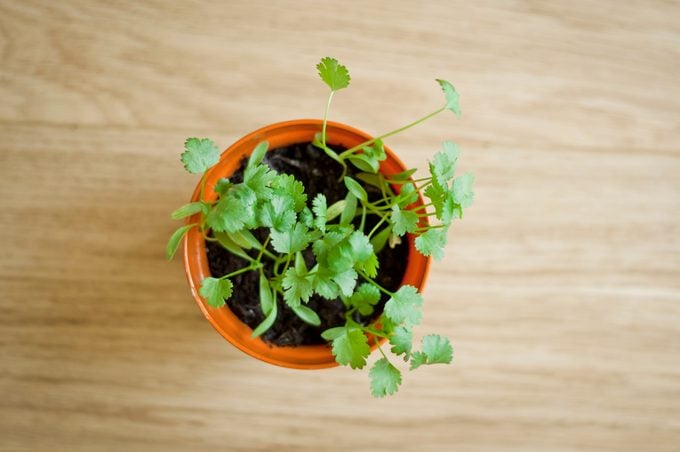 gollykim/Getty Images
gollykim/Getty Images
Cilantro Seeds vs. Starts
Cilantro is a finicky seed to start, but with the right tools, you’ll find yourself on the path to your own plants, year round. While you can buy young plants, usually called “starts”, cilantro starts are only available for purchase from spring through summer. If you want to grow outside of that time, you’re on your own.
Since cilantro also tends to bolt easily (go to seed), you’ll want to succession plant, meaning that you’ll start new cilantro every month or so. For this reason, it’s wise to learn how to successfully and confidently seed your own cilantro plants.
How to Pot Your Cilantro Seeds
To start cilantro seeds, you’ll want a seed tray, seed starting mix, a heat mat and a grow light. During the fall, winter and spring, you just don’t get enough light and heat through the windows to start seeds any other way.
Fill your seed tray with damp seed starting mix. In each cell of your seed tray, place 2-4 cilantro seeds under 1/2 inch of soil. You can use a pencil to make a divot 1/2 inch deep. Cover the seeds with the soil, and then water the tray so that water comes out the bottom.
If your tray did not come with a plastic dome, use plastic wrap to cover the top. Now set the seed tray onto the heat mat, under the grow light.
How Much Sunlight Does a Cilantro Plant Need?
You can either leave the grow light and the heat mat on twenty four hours a day, or 16 hours a day and turn them off at night. Within two weeks, you should see sprouts that will grow into your own cilantro starts. A grown cilantro plant needs some sunlight, at least eight hours a day. A window with direct sun is ideal.
How Much Water Does a Cilantro Plant Need?
Until you have germination, you should be watering enough to ensure that the seed starting mix is always damp. You’ll be able to tell you’re doing it correctly if you see condensation on the interior of the plastic dome or plastic wrap.
Once the cilantro seeds have sprouted, you can remove the plastic dome or wrap, and continue watering it as often as needed for the seedling to remain damp.
When to Transplant Your Cilantro Seedling
When your seedling is 1-2 inches tall, you can transplant it into a larger pot. It’s best to transplant each cell into a larger pot, 6-8 inches wide, as soon as the cilantro is ready.
Editor’s Note: You don’t have to transplant your cilantro; it would be fine in the seedling tray, under the light—but it would never get tall or bushy, as the roots don’t have enough room.
When transplanting the cilantro, add some potting soil to the bottom inch or two of the pot, and then carefully place the seedling in the middle of the pot, taking care to not disturb the roots. Gently pack soil in around the seedling, and then make sure to water it enough that water comes out the bottom of the pot. Leave the pot with your new transplant away from direct sunlight for twenty four hours so it may recover.
How Often to Prune Cilantro Leaves
With your new plants on their way to being fully grown, you should take care to prune the entire herb plant back to 2-3 inches tall once a week. This encourages it to grow bushier and more robust, and discourages the cilantro from bolting.
When you do harvest your cilantro, use the leaves and the stems together in recipes. The stems provide an amazing crunch.
When to Harvest Cilantro
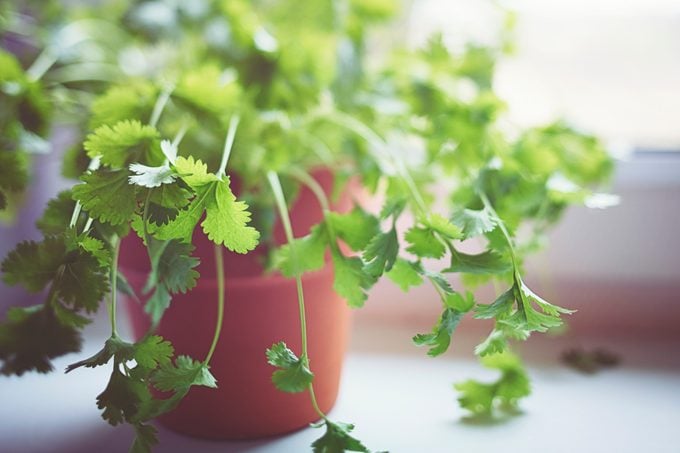 Rike_/Getty Images
Rike_/Getty Images
If you continue chopping your cilantro plant once a week, you should be able to continue to harvest it for months. Cilantro will continue to grow leaves and stems, with the stems getting woodier over time, which is less enticing to eat.
At some point, you’ll notice the stems shooting up, and beginning to grow many fine wispy leaves and flowers. This is the cilantro bolting. Don’t despair, though, because this means it is going to seed. If you allow it to continue growing, within a week or two you’ll have a bevy of tiny green seeds at the ends of the stems. This is cilantro seed, and it is soft enough while fresh to eat all by itself, use as a garnish, or pickle. You can also allow them to dry, and you’ll have seeds to start another round of cilantro.
Once the cilantro has gone to seed, it’s time to compost the plant and start with a fresh one. By starting new cilantro each month, you’ll always have a seedling waiting to be transplanted when you need one. Looking for more plants? Here are a few tips for growing mint indoors.
Our Best Recipes for Fresh Cilantro
 Fajita-Style Shrimp and Grits
Fajita-Style Shrimp and Grits
I combined two of my favorite dishes—fajitas and shrimp with cheesy grits—into this spicy one-dish meal. For more heat, use pepper jack cheese instead of a Mexican cheese blend. —Arlene Erlbach, Morton Grove, Illinois
Go to Recipe
Not everybody's a fan of this herb. Here's the scientific reason why some people think
cilantro tastes like soap.
Halibut Soft TacosHalibut fish tacos, sitting atop lettuce and tortillas and dressed with mango salsa, make a warm-weather meal that's quick, colorful and full of nutrients. You can add any taco topping you like.
Mexican Street Corn ChowderCorn is one of my all-time favorite vegetables, so when it's in season, I always make this super easy soup in the slow cooker. —Rashanda Cobbins, Food Editor,
Taste of Home
Tangy Cilantro Lime Confetti SaladI love standout salads that burst with flavor—the kind that make you feel as if you're splurging without having to eat that piece of chocolate cake. This is one of my very favorites, and everyone I serve it to loves it as well. —Jasey McBurnett, Rock Springs, Wyoming
Psst! Learn how to
grow your own cilantro indoors so you always have it fresh and on hand.
Mojito Pulled PorkThis fork-tender pulled pork tastes fabulous on a bun, or in a wrap or tortilla. My kids like it spooned over rice in its citrus-flavored juices. —Mindy Oswalt, Winnetka, California
Quick Cilantro ChickenIf you’re a fan of cilantro, you’ll definitely like this chicken dish. The cilantro adds herbal flavor, melding with the tangy lemon juice and caramelized onions. —Mary Pipkin, Melba, Idaho
Open-Faced Breakfast Banh MiI love banh mi sandwiches because of the delicious pickled veggies. I also love naan, so I combined the two for a fun morning dish! We make these breakfast banh mi on the weekend. —Lori McLain, Denton, Texas
Chili VerdeThis chile verde recipe is one of my family's favorites. We enjoy it any time of year, but it's especially good on a cool and rainy day. —
Sherrie Scettrini, Salinas, California
Peppered Cilantro RiceThis colorful confetti rice is a traditional dish in Puerto Rico. We enjoy it in the summer alongside grilled shrimp kabobs, but it is good with most any entree.
-Laura Lunardi of West Chester, Pennsylvania
Shrimp Tostadas with Lime-Cilantro SauceShrimp tostadas, with their pile of fresh vegetables and succulent shellfish on crispy edible "plates," look fun and taste amazing as a weeknight dinner or party spread.
Southwest Frito PieI got a real culture shock when we moved to New Mexico several years ago, but we grew to love the food. Now back in South Carolina, we still crave New Mexican dishes, and this is one of my go-to favorites. —Janet Scoggins, North Augusta, South Carolina
Spicy Sweet Potato Chips & Cilantro DipThis irresistible combo could become your new signature snack food. Park the spicy baked chips next to a bowl of the cool, creamy dip and let the gang have at it. What a fantastic twist on traditional chips and dip! —Elizabeth Godecke, Chicago, Illinois
Cilantro-Lime ChickenAs a working mom and home cook, I strive to have fabulous, flavor-packed dinners that make my family smile. Nothing is more awesome than a slow-cooker recipe that makes it seem as though you've been cooking in the kitchen all day! —Mari Smith, Ashburn, Virginia
Southwestern Pasta SaladI created this southwestern pasta salad for a friend who owns a catering business. I was told it was a hit at her events and it's now among the most-requested dishes. —Valonda Seward, Coarsegold, California
Turkey Enchiladas VerdesPlanning a fiesta night? These authentic-tasting enchiladas in spicy green sauce will please the whole family and you’ll be thankful for turkey leftovers. —Karyn Power, Arlington, Texas
Thai Salad with Cilantro Lime DressingI created this salad to replicate one I tried on a cruise several years ago. It goes over very well at family gatherings and potlucks year-round. We love the spice of the Thai chile, but if your family isn't into spice, feel free to leave it out. It will still be delicious! —Donna Gribbins, Shelbyville, Kentucky
Peppy Peach SalsaGarden-fresh salsas are one of my favorite condiments. So when I saw a recipe for peach salsa in the newspaper, I couldn't think of anything that sounded better. —Jennifer Abbott, Moraga, California
Lime and Dill Chimichurri ShrimpChimichurri is a very popular condiment in Argentina and Uruguay and is most often used as a dipping sauce or a marinade for meats. My chimichurri shrimp version incorporates dill and lime, which give it a brighter flavor, making it ideal for spring and summer entertaining. —Bonnie Landy, Castro Valley, California
Spiced Grilled Chicken with Cilantro Lime ButterThis grilled chicken gets a lovely pop of color and flavor from the lime butter—don't skip it! —Diane Halferty, Corpus Christi, Texas
Chimichurri SteakThis flavorful chimichurri steak recipe comes together in less than 30 minutes. Spoon the bright, zesty, herbaceous sauce over any type of grilled steak, like flat iron, top sirloin, ribeye, flank or skirt steak.
Creamy Lime Pie with Fresh BerriesI combined the tangy tastes of lime and cilantro with cream cheese for this unusual berry pie that showcases seasonal fruit. The ginger cookies add zip to the crust. —Anneliese Barz, Fort Mill, South Carolina
Vegetarian Pad ThaiThis is a simple pad thai loaded with crisp vegetables and zesty flavor. It’s quick, simple, and fresh-tasting. —Colleen Doucette, Truro, Nova Scotia
Southwestern GoulashI had some extra cilantro in the fridge and didn't want to throw it away. Instead, I came up with this delightful and filling family recipe. Everyone just loved it! —Vikki Rebholz, West Chester, Ohio
Jicama Citrus SaladNever tried jicama? It is a crunchy Mexican turnip, and I love to use it in this super easy salad. The jicama is ideal alongside the vibrant flavors of the tangerines and shallots. Between the sweet and sour flavors in this salad and its crunchy texture, it's all delish if you ask me. —Crystal Jo Bruns, Iliff, Colorado
Orange-Glazed Chicken & Chorizo MeatballsThese tasty southwestern meatballs warm up a buffet. I add pomegranate seeds, jalapeno pepper jelly and cilantro to make everything pop with color. —Jeanne Holt, Mendota Heights, Minnesota
Cilantro Ginger CarrotsPeppery-sweet ginger and cooling cilantro have starring roles in this colorful side of crisp-tender carrots. The veggie goes from pan to plate in a twinkling. —
Taste of Home Test Kitchen
Cilantro-Avocado Tuna Salad SandwichesLime juice and cilantro in tuna salad – who knew? This recipe for avocado tuna salad came to me as a way to have a protein-packed meal with lots of pizzazz. —Heather Waldorf, Black Mountain, North Carolina
Flank Steak with Cilantro & Blue Cheese ButterI love the combination of the sweet citrus marinade and the strong tang of the blue cheese butter. And my kids just love flank steak. —Gwen Wedel, Augusta, Michigan
Cilantro-Lime Chicken SandwichesYou can use any type of bread or roll for this sandwich. We like the ciabatta, but have used other breads and rolls, whatever I might have handy. You can also pan fry the chicken if you can't get to a grill.—Debbie Speckmeyer, Lakewood, California
Cilantro-Lime RiceMy family's favorite Mexican restaurant serves a similar rice as a side dish. I threw this together one night when I was making fajitas, and everyone loved it! It's such an easy side dish and pairs well with kabobs on the grill, too. —Robin Baskette, Lexington, Kentucky
Mexican Breakfast CasseroleThis versatile and tasty Mexican breakfast casserole is ideal for a slow Sunday brunch with friends. Add a side of mimosas for extra fun.
Cilantro Salad DressingUse this zippy dressing over greens or hot or cold boiled potatoes. You'll love it! —Sara Laber, Shelburne, Vermont
Watermelon and Spinach SaladSummer's the perfect time to toss up this watermelon salad. You'd never expect it, but spinach is awesome here. Eat it and feel cool on even the hottest days. —Marjorie Au, Honolulu, Hawaii
Black Bean & Corn QuinoaSome vegan quinoa recipes are boring, but this one definitely isn't. My daughter’s college asked parents for the best quinoa recipes to use in the dining halls. This healthy quinoa recipe fits the bill. —Lindsay McSweeney, Winchester, Massachusetts
Sesame Cilantro ShrimpOn days when I don't feel like spending much time in the kitchen, I reach for shrimp. I can have a hot meal in the table in 10 minutes. —Tami Penunuri, League City, Texas
Radish, Carrot & Cilantro SaladBright carrots and radishes pop in this citrusy salad. My husband likes it with anything from the grill. I like to pile it on tacos. —Christina Baldwin, Covington, Louisiana
Garlic Tomato BruschettaI drew inspiration from my grandma’s recipe for this garden-fresh bruschetta. The crisp bread and tomato goodness make a great party appetizer, but the dish also works alongside your favorite Italian entree. —Jean Franzoni, Rutland, Vermont
Cilantro PotatoesFresh cilantro gives an exotic Syrian-style flavor to these easy, delicious skillet potatoes. They’re a creative complement to Mom’s tangy kabobs. —Weda Mosellie, Phillipsburg, New Jersey
Shrimp GazpachoHere’s a refreshing take on the classic chilled tomato soup. Our twist features shrimp, lime and plenty of avocado. —Taste of Home Test Kitchen
Sweet Potatoes with Cilantro Black BeansAs a vegan, I'm always looking for impressive dishes to share. Sweet potatoes loaded with beans and a touch of peanut butter are one of my mom’s favorites. —Kayla Capper, Ojai, California
Cilantro Lime ShrimpA quick garlicky lime marinade works magic on these juicy shrimp. They come off the grill with huge flavors perfect for your next cookout. —Melissa Rodriguez, Van Nuys, California
Cilantro Beef TacosWhen I have leftover steak, it’s time to make cilantro tacos. Set out bowls of toppings like lettuce, tomatoes, sour cream, avocado and salsa. That’s a fiesta. —Patti Rose, Tinley Park, Illinois
Cauliflower CevicheMy 87-year-old mom showed me how to make this delicious vegetarian recipe that tastes so much like seafood ceviche. I often serve it with crackers on the side. —Beatriz Barranco, El Paso, Texas
































